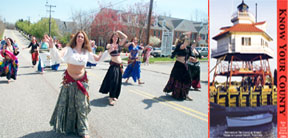 |
|||||
|
Volume 12, Issue 17 ~ April 22-28, 2004
|
|||||
|
|
Dock of the Bay Scrimmages Against Poverty As Pulitzer prize-winning author David K. Shipler talked about his new book in the crowded main gallery at Banneker-Douglass Museum, it sounded as if Anne Arundel’s Community Action Partnership was on the right track.
What he found was that theories of poverty — blaming individual failings on one hand and society’s failings on the other — are both half wrong and half right. People suffer from both bad choices and bad fortune, Shipler concluded. Poverty, he began to see, was its own ecology: a system of interacting elements that thrives when all the elements are interacting. The programs most successful in helping people out of poverty are those that address the interacting elements of a person’s life. The Anne Arundel County Community Action Partnership, whose head, Yevola S. Peters, introduced Shipler at Banneker-Douglass, works to expand the part of the Partnership that does just that. The Partnership helps the working poor and other people living in poverty in the county. Its outreach includes Head Start, youth services, microenterprise, senior nutrition, housing opportunities and energy assistance. Going further, the Partnership helps people get access to services they’re eligible for. A counselor sits with each client to assess needs, set goals, make a plan and help the plan work in the real world by, for example, arranging that car washer’s ride to an appointment. The Partnership has applied for a grant to fund a coordinator to develop a volunteer program to help more people. “It’s a great concept, and a very critical one,” Shipler told Bay Weekly. Shipler pointed up another way The Partnership is on the right track. “Legislators think they write the legislation,” he said, “but where the receptionist encounters the client is where the law is really written.” Community Action’s receptionist is praised as warm and welcoming those people. “Mrs. Barbara Silesky, the world’s most courteous receptionist, is giving [us] a good reputation in the community,” a recent newsletter noted. The state of Maryland may also be on the right track. Both houses of the legislature have passed a living-wage bill to raise the minimum wage for any business doing business with the state. Shipler has studied living wage legislation in other parts of the country, where some laws have been in effect for several years. “They do help people,” he said — and do so without overburdening business. “These laws do not seem to have hurt government in terms of expenses,” Shipler said, noting that companies bidding for contracts understand what the wage has to be and make their bids on that basis. If Gov. Robert Ehrlich signs the bill, Maryland’s will be the first living-wage law enacted at the state level. — Lucy Oppenheim
Q. Will adding organic material to my garden every spring eventually transform the clay-type soil into an easily workable loamy soil? (That’s the best type, right?) Or will it continue to be an annual battle? A. Loam is the name for a soil texture with a fairly even mix of sand, silt and clay. Clay particles are very small with comparatively little space between particles for water and oxygen: very important. That’s why it takes longer for clay soils to become moist, but once they get wet the water doesn’t drain out as quickly as in loam or sandy soils. Organic matter is bulky and makes bigger pore space between particles, thus improving the structure and making it easier to work over time. The good news is that clay soil is actually quite nutrient rich. In three to four years, adding lots of organic matter will greatly improve the structure and fertility of your clay soil, but it won’t change the texture of the mineral component. Gone Geocachin’ A new pastime sweeping Maryland has hikers trekking and navigating through field and forest with a fresh purpose.
On a typical geocache adventure, the hiker starts with the longitude and latitude coordinates of nearby caches, which are hidden containers usually including a logbook. Coordinates are printed at websites such as www.Geocaching.com, a website for cache-enthusists run by a company called Groundspeak. Programming in the waypoint, or coordinates, for a cache, they figure out where they’re headed. Next, they hit the trails. When a cache is found, the discoverer signs the logbook inside. Often, caches hold other treasures. “McDonald’s toys, coins, buttons, keychains,” says Cole. “Trinkets that are only valuable because they are unique or different.” Geocachers can make a trade if they leave a new item in the cache. A “hitchhiker” item may have a note instructing the geocacher to move it to the next cache visited. A candle has traveled from Australia to Arizona in this way, according to the Geocaching.com website. Multi-caches, the trickiest of geocaches, involve a series of caches and may include mathematical calculations or trivia that must be unpuzzled before the next geocache location is revealed. Most caches are rated for difficulty. A four-star cache might entail unraveling a puzzle and will be much more difficult to find than a one-star cache. Smaller containers also increase the challenge of the sport. “The challenge is in the hunt,” notes Cole. Geocachers who set up caches keep them concealed and out of sight of regular hikers. They also maintain caches and check them regularly. Fans of this new sport have set up such caches all over the world. According to the Maryland Geocaching Society, 85,000 exist in more than 190 countries. Maryland alone has more than 600 caches. Right now, Maryland is in the midst of a geocaching extravaganza, Cache Across Maryland, where adventurers locate 10 caches concealed from Ocean City to Frostburg. This first-time event kicked off on April 1. By mid-April, some geocachers had already logged more than 1,000 miles of driving and hiking. Working in groups or going solo, more than 40 geocachers have registered to traverse Maryland in search of the 10 caches. Seeking the carefully hidden containers, they stamp their Geo-Passport at each cache before heading to the next geocache location. Each of the 10 locations also contains a few digits of the secret coordinates to the final location. A celebration with prizes is in store for those who geocache their way to this last location on May 8. Geocachers also love that they can cache-hunt with family and pets. Kids and dogs enjoy the hike and opportunity to explore the outdoors too. And, says Cole, “you can see really amazing things. We’ve seen minks, foxes and nesting geese.” To find the Maryland Geocaching Society and get started on your own geocaching adventure, visit www.mdgps.org. —Carrie Steele 350-Plus Answers to Calvert Questions From marching bands to belly dancers to farm machinery to martial artists, about everything you needed to know about Calvert County marched by to mark the county’s 350th anniversary April 17. In Annapolis, the prediction for crabs this year is moderate, not bountiful. That’s the report from the winter dredge survey by Maryland and Virginia, which woke up sleeping crustaceans at 1,500 locations to make their count. Officials reported that the population is at least stable, rather than continuing to drop… In Oklahoma, a man shopping at the tree section at his local Lowe’s Home Improvement Warehouse near Tulsa thought he had pricked his hand on a thorn — until a rattlesnake crawled away. Shoppers killed the snake and sent it to the hospital with the unidentified man. A spokesman said the store is vigilant about snakes and that the bite was an isolated case… In New York, actress Kim Basinger had enough of her fellow actor and former husband, Alec Baldwin, two years ago. Now she plans to auction off jewelry he gave her, including a 3.7-carat diamond engagement ring, to raise money for the care of retired circus animals. All told, 11 pieces of her jewelry could raise $100,000 for the Performing Animal Welfare Society’s refuge for old elephants, lions and other captive wildlife… Our Creature Feature comes from Denmark, where picky chimpanzees at the Copenhagen Zoo may need their own Whole Foods Market. That’s because they routinely choose organic bananas and fruit over traditional varieties, reports Agence France-Press. |
||||
|
© COPYRIGHT 2004 by New Bay Enterprises, Inc. All rights reserved. Last updated April 22, 2004 @ 1:20am. |




 “This year’s 100-page guide is special because of its in-depth coverage across the entire spectrum of the county, from its government agencies to the many volunteer and artistic ventures available to residents and tourists alike,” says Roberta Safer, the project’s managing editor.
“This year’s 100-page guide is special because of its in-depth coverage across the entire spectrum of the county, from its government agencies to the many volunteer and artistic ventures available to residents and tourists alike,” says Roberta Safer, the project’s managing editor.